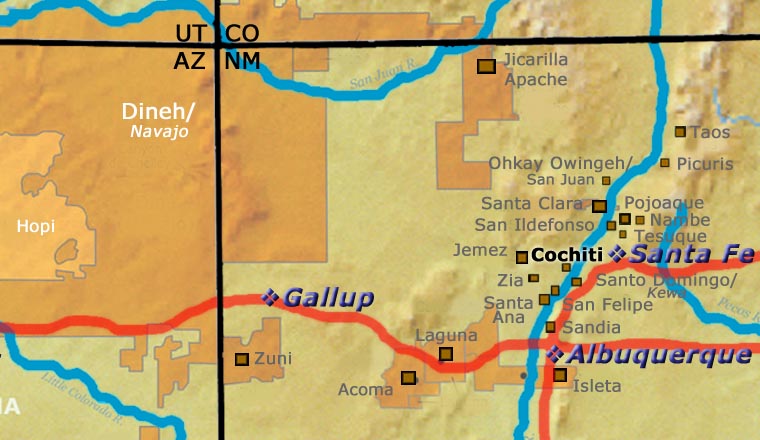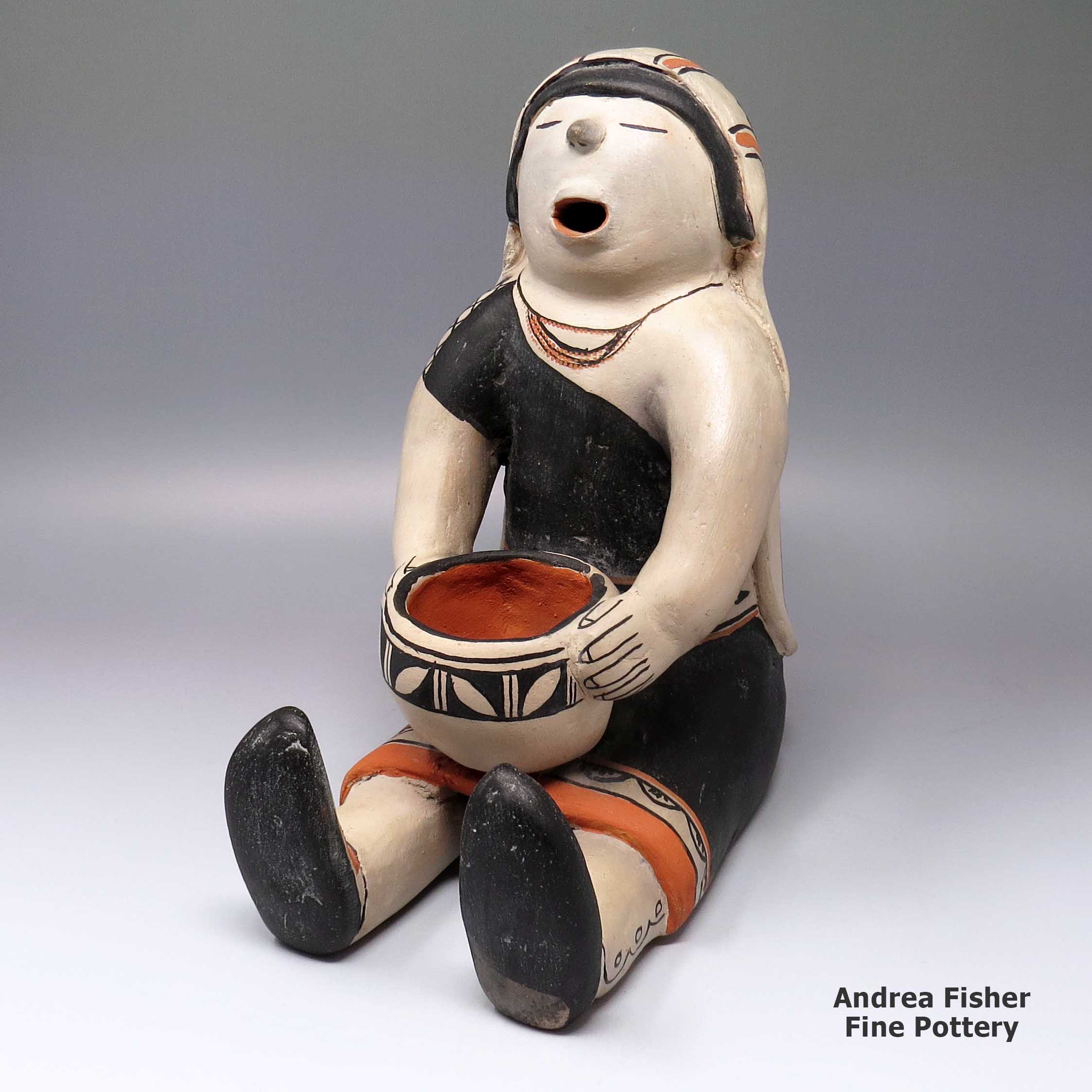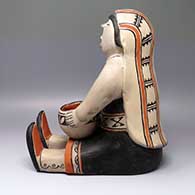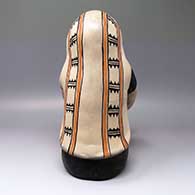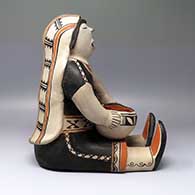
Helen Cordero
Cochiti
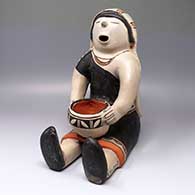
Helen Cordero (1915-1994) was a potter from Cochiti Pueblo who became famous for her "storyteller" figures. Earlier in life, Helen had tried her hand at beadwork and leather-working but nearly all the money she made selling her works went into purchasing supplies to keep going. Then her husband's aunt suggested she try making pottery.
It was a time when pottery making had almost died out in Cochiti but her cousin had learned the ancient ways as a child and Helen worked with her for six months learning the process and getting good at it. However, she was trying to make pots, bowls and jars but nothing ever came out quite right. Seeing she was frustrated, her cousin suggested she make figurines like many Cochiti pottery makers had been producing years before.
It was like Helen had found her true calling as she spent several years making countless little figures of animals, birds and people (male and female figures eight to nine inches tall). In 1960, Helen displayed some of her figures at Santo Domingo Pueblo Feast Day and attracted the attention of Alexander Girard, a well-known folk art collector. He bought everything she had and encouraged her to make more. He also asked that she make them larger and he soon commissioned a 250-piece nativity set from her. Shortly after that, he asked her to make a large seated figure surrounded by many children, a situtation similar to many of the "Singing Mothers" made by other Cochiti potters.
The pueblos had a long tradition of Singing Mother figurines but Helen took that motif a step further: in honor of her grandfather (a tribal storyteller who knew many stories of the Cochiti oral history) she built a seated male figure eight inches high with five children perched on it. It quickly became known as a "storyteller." The fact the figure was male and had children figures perched on it changed Pueblo pottery history and started a new tradition. That was in 1964.
The idea caught on quickly among nearly all the pueblo pottery makers and shortly, each pueblo had developed its own version of the storyteller complete with local dress, designs and added configurations. Helen's intent was that storyteller figures be male (and she never made a female storyteller) while Singing Mothers were always female. That line has been blurred in that virtually all similar "contexts" are called storytellers. And "context" is the word because there are now many figurines that are presented as animal or bird storytellers...
When Helen displayed her storytellers at the New Mexico State Fair in 1964, she walked away with 1st, 2nd and 3rd place ribbons. In 1965 she earned the 1st, 2nd and 3rd place ribbons at the Santa Fe Indian Market. Her career was off and running and when she did her first one-person show in Scottsdale, AZ in 1973, it was sold out before the show opened.
In 1985 Helen was honored as a Santa Fe Living Treasure. In 1986 she became a National Heritage Fellow.
"I don't know why people go for my work the way they do. Maybe it's because to me they aren't just pretty things that I make for money. All my potteries come out of my heart. They're my little people. I talk to them and they're singing. If you're listening, you can hear them." - Helen Cordero, from The Pueblo Storyteller (1986)
100 West San Francisco Street, Santa Fe, New Mexico 87501
(505) 986-1234 - www.andreafisherpottery.com - All Rights Reserved

Cochiti Pueblo
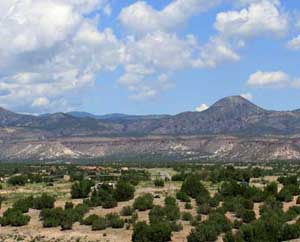
View west across Cochiti Pueblo
Cochiti Pueblo lies fifteen miles south of Santa Fe along the west bank of the Rio Grande. Frijoles Canyon in what is now Bandelier National Monument is the site of the pueblo's most recent ancestral home. The Eastern Keresans may have relocated to the Bandelier area from the Four Corners region around 1300.
Cochiti legend says that Clay Old Woman and Clay Old Man came to visit the Cochitis. While all the people watched, Clay Old Woman shaped a pot. Clay Old Man danced too close and kicked the pot. He rolled the clay from the broken pot into a ball, gave a piece to all the women in the village and told them never to forget to make pottery.
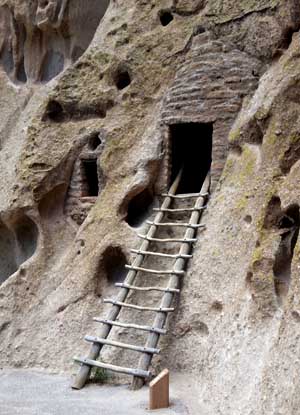
At Bandelier National Monument
In prehistoric times, human effigy pots, animals, duck canteens and bird shaped pitchers with beaks as spouts were common productions of the Cochiti potters. Many of these were condemned as idols and destroyed by the Franciscan priests. That problem stopped when the Spanish left in 1820 but the fantastic array of figurines created by Cochiti potters was essentially dormant until the railroad arrived. Then Cochiti potters were among the first to enter the tourist market and they produced many whimsical figures into the early 1900s. Then production followed the market into more conventional shapes.
Legend has it that a Ringling Brothers Circus train broke down near Cochiti Pueblo in the 1920s. Supposedly, the tribe's contact with the ringmaster, trapeze artists, opera singers, sideshow quot;freaks" and exotic animals paved the way for a variety of new figural subjects. However, shortly after the railroad passed through, a delegation of Cochiti men got on the train and traveled to Washington DC. There they were introduced to the President, spoke to Congress, and were taken on a tour of the "highlights" of American civilization in Washington and in New York City, incuding the Metropolitan Opera, the Bronx Zoo and a performance of the Ringling Brothers Circus. As none of the men could read or write, nor draw, what they brought back to Cochiti was what they remembered of things they had never seen before. The stories they told must have been wild. An astute observer will find angels, nativities, cowboys, tourist caricatures, snakes, dinosaurs, turtles, goats, two-headed opera singers, clowns, tattooed strongmen, Moorish nuns and even mermaids in the Cochiti pottery pantheon, many produced only since the early 1960s and based on characters described in Cochiti's oral history.
A few modern potters make traditional styled pots with black and red flowers, animals, clouds, lightning and geometric designs but most Cochiti pottery artists now create figurines. Most notable is the storyteller, a grandfather or grandmother figure with "babies" perched on it. Helen Cordero is credited with creating the first storyteller in 1964 to honor her grandfather. The storyteller style was quickly picked up by other pueblos and each modified the form to match their local situation (ie: clay colors and tribal and religious traditions). In some pueblos, storytellers are also now made as drummers and as a large variety of animals.
Today, Cochiti potters face the challenge of acquiring the clay for the white slip. Construction of Cochiti Dam in the 1960s destroyed their primary source of their trademark white slip and gray clay. Now the white slip comes from one dwindling source at Santo Domingo, Cochiti Pueblo's neighbor to the south.
Most outsiders who visit Cochiti Pueblo these days do so on the way to or from either the recreation area on Cochiti Lake or Kasha-Katuwe Tent Rocks National Monument.
100 West San Francisco Street, Santa Fe, New Mexico 87501
(505) 986-1234 - www.andreafisherpottery.com - All Rights Reserved

Cochiti
$ 8600
poco2f171
Polychrome seated figure holding jar
9.25 in L by 5.25 in W by 10.25 in H
Condition: Very good, normal wear and pitting
Signature: Helen Cordero Cochiti. N Mex.
100 West San Francisco Street, Santa Fe, New Mexico 87501
(505) 986-1234 - www.andreafisherpottery.com - All Rights Reserved

Santiago Cordero Family Tree
Disclaimer: This "family tree" is a best effort on our part to determine who the potters are in this family and arrange them in a generational order. The general information available is questionable so we have tried to show each of these diagrams to living members of each family to get their input and approval, too. This diagram is subject to change should we get better info.
- Santiago Cordero (1876-) & Lorenza Cordero (c. 1874-)
- Juanita Cordero Arquero (c. 1906-)
Her students:
- Felecita Eustace (1927-2016) & Ben Eustace (Zuni)(c. 1920s-)
- Joseph (Lambert) Eustace (1960-)
- Helen Cordero (see below)
- Felecita Eustace (1927-2016) & Ben Eustace (Zuni)(c. 1920s-)
- Helen Cordero (1915-1994) & Fred Cordero
- George Cordero (1944-1990) & Kathy Cordero
- Buffy Cordero (1969-)
- Toni Suina (c. 1948-) & Del Trancosa (1951-)
- Leonard Trujillo (1936-2017) & Mary Trujillo (1937-2021)
- Geraldine Trujillo
- April Trujillo
- Geraldine Trujillo
- George Cordero (1944-1990) & Kathy Cordero
- Ramona Cordero
- Santiago Cordero (1876-) & Damacia Cordero (1905-1989)
- Josephine Arquero (1928-)
- Martha Arquero (1944-)
- Gloria Herrera
- Marie Laweka (1931-2002)
- Josephine Laweka (1960-2008)
Damacia's students: - Dorothy Trujillo (Jemez/Laguna, married into Cochiti) (niece, 1932-1999)
- Judith A. Suina (1960-)
- Cecilia V. Trujillo (1954-)
- Onofre Trujillo Jr. (c. 1969-) Dorothy's students:
- Norma A. Suina (1944-)
Some of the above info is drawn from Southern Pueblo Pottery, 2000 Artist Biographies, by Gregory Schaaf, © 2002, Center for Indigenous Arts & Studies
Other info is derived from personal contacts with family members and through interminable searches of the Internet and cross-examination of the data found.
(505) 986-1234 - www.andreafisherpottery.com - All Rights Reserved
